The HTC One M9 Review: Part 1
by Joshua Ho on March 22, 2015 7:00 PM EST- Posted in
- Smartphones
- HTC
- Qualcomm
- Mobile
- Snapdragon 810
- One M9
System Performance: Snapdragon 810
We've been able to test Snapdragon 810 before, but it was only in the context of Qualcomm’s developer platform tablets and phablets, which have a higher possible TDP than shipping devices, and generally doesn’t have any need for battery life as these devices usually spend all of their time plugged into a charger. Thus, the One M9 represents our first experience with a Snapdragon 810 device with shipping software and hardware. HTC noted during the review process that our devices were running non-final software, and we received an OTA update that significantly changed the thermal throttling characteristics of the device, but this seems to have only affected performance in situations where the SoC was nearing maximum acceptable skin temperatures as performance in these benchmarks were relatively unchanged.
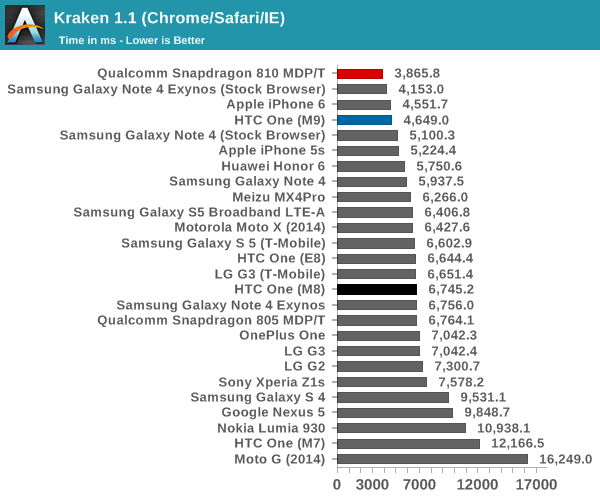
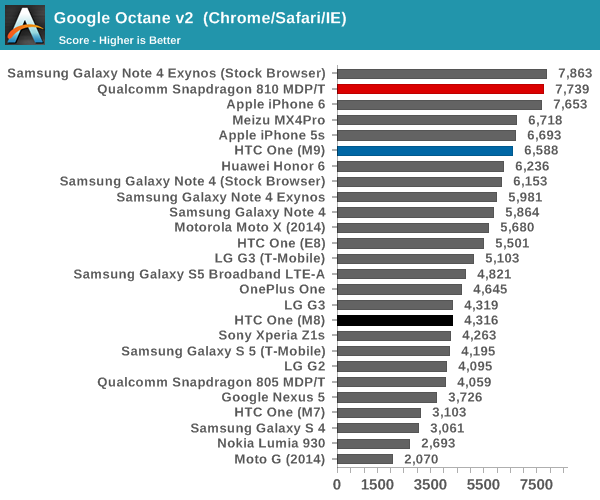

In our first few browser tests, we can see that the One M9 posts dramatically lower performance than the Snapdragon 810 MDP/T, which seems rather strange. However, using CPUBurn to try and load just a single thread reveals that without HTC’s CPU cheats, it’s basically impossible to get the A57 cluster beyond 1.5 to 1.6 GHz. It's important to emphasize that this isn't new behavior, as this was present on pre-release software as well, which means that HTC didn't do this at the last minute.
For those that are unfamiliar with how HTC's CPU cheats work, HTC continues to rely on some level of benchmark detection, and it seems that when a benchmark is detected it enables a "High Performance" mode in the developer settings with no option to disable this mode. It's possible to work around this mode by using benchmarks that evade such detection mechanisms (and we do), but it's also possible manually toggle this mode on and off if a benchmark isn't detected. This benchmark mode appears to relax throttling constraints, but more obviously it enables one to go from a maximum of 1.6 GHz to the rated 2.0 GHz of the Snapdragon 810 for extended periods of time. However, even in this mode we can see that a sustained load of a single thread on the A57 cluster will cause the cluster to throttle to 1.7 GHz in this mode, while without this mode enabled we see that a single thread will eventually cause the A57 cluster to clock around 1 to 1.2 GHz. If the normal governor does allow the SoC to reach 1.9 GHz, I can't really perceive the amount of time that it does reach such a speed.
The most concerning result is WebXPRT, which is a bursty workload that runs over a few minutes, which suggests that we’re already seeing thermal throttling in the M9.

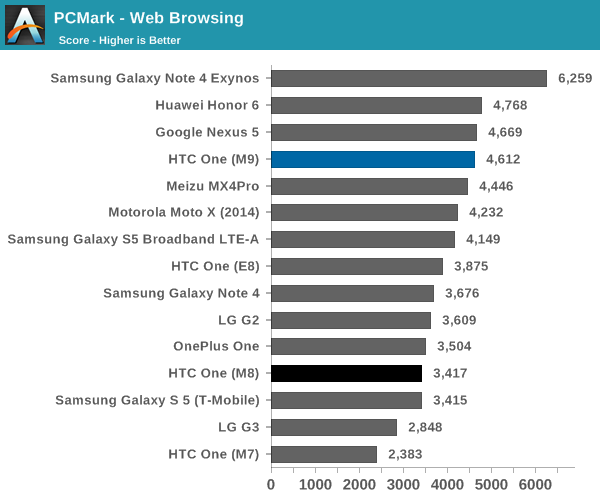
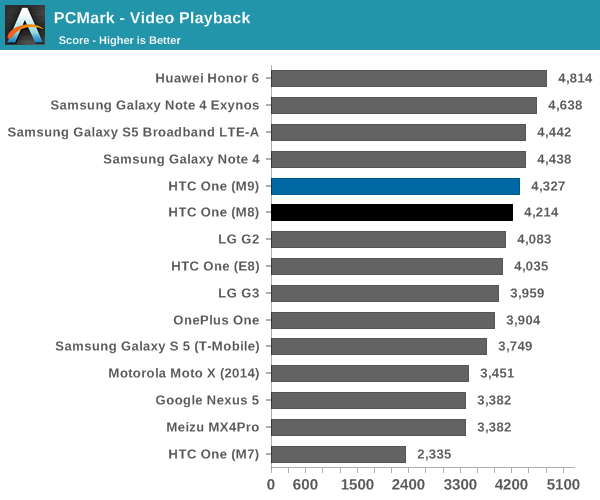
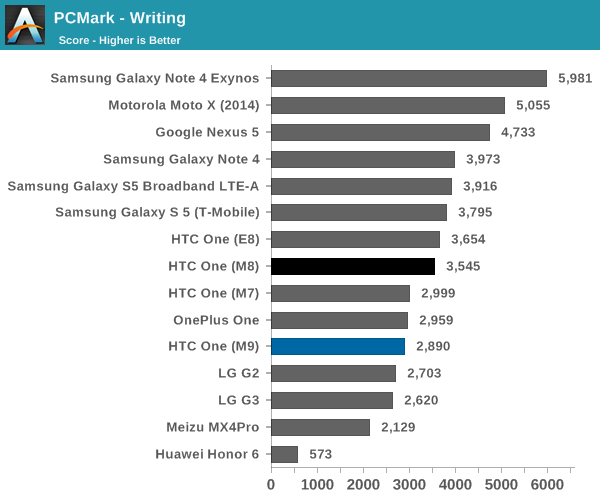
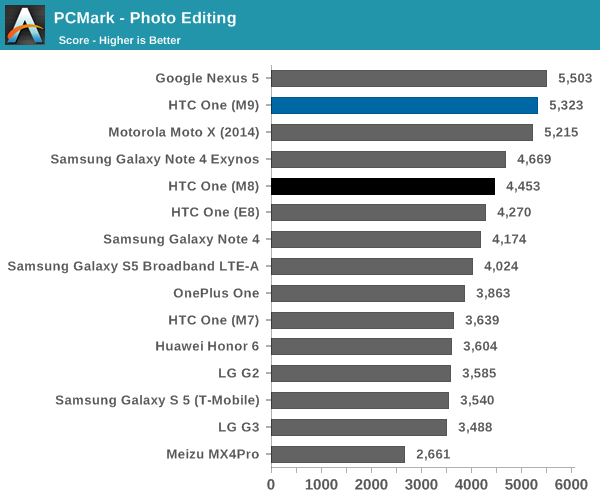
In PCMark, which is a benchmark that tends to focus strongly on race to sleep scenarios, we can see that the Snapdragon 810 appears to significantly trail behind the Exynos 5433, which is on a similar process node. It's hard to say whether this is due to the scheduler configuration or differences in the physical design of the SoC, but at any rate this is another concerning performance from the SoC of the One M9.
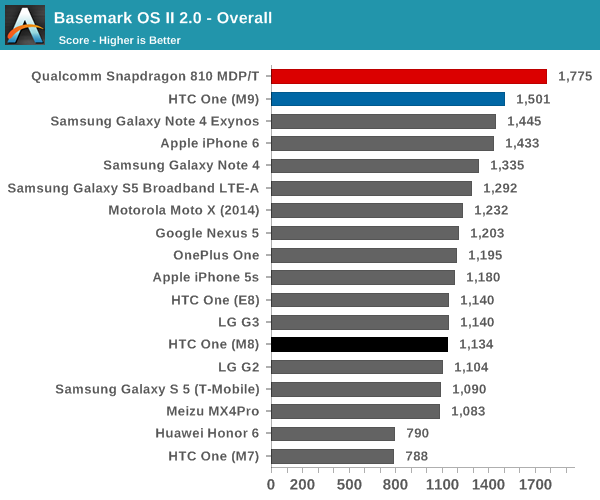

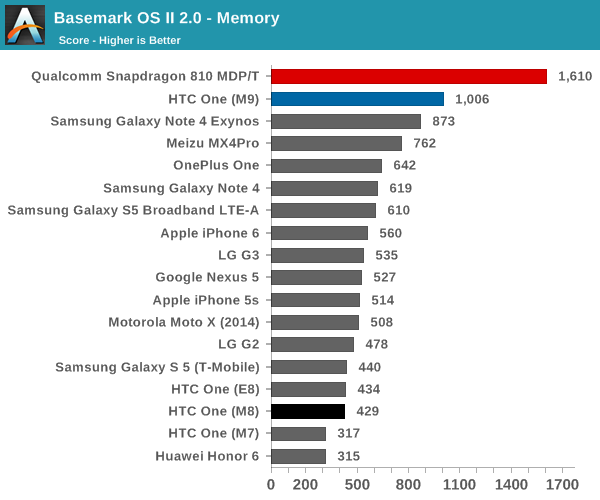
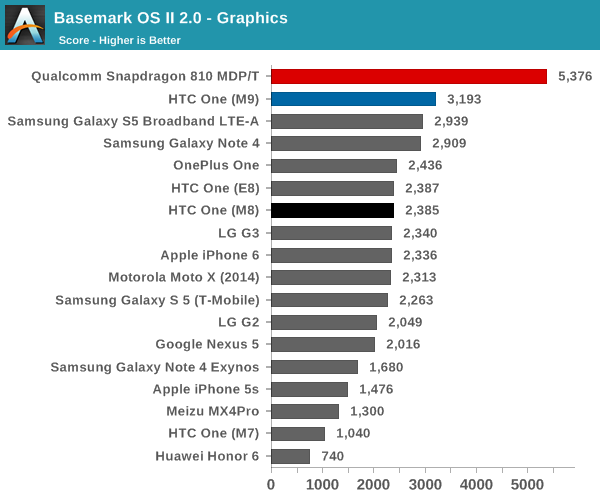
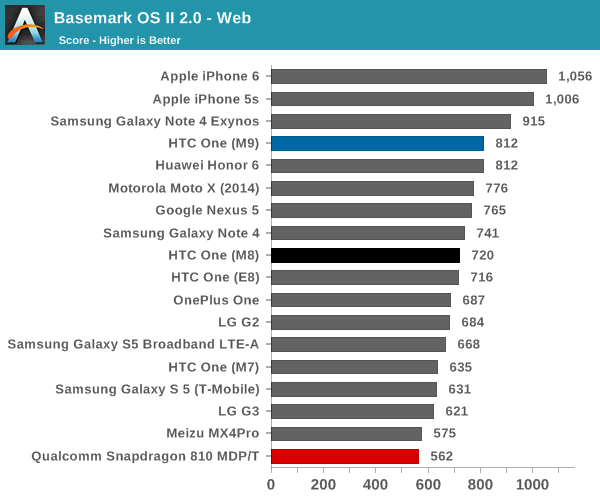
Moving on to the general system performance tests, we see that the M9 delivers a reasonable improvement in performance over the M8, but most of the difference seems to come from the GPU and storage performance rather than anything else that was tested. Overall, the Snapdragon 810 really isn’t off to the best start in any test we’ve thrown at it so far. To see if Snapdragon 810 has any redeeming features we’ll look at GPU performance next.


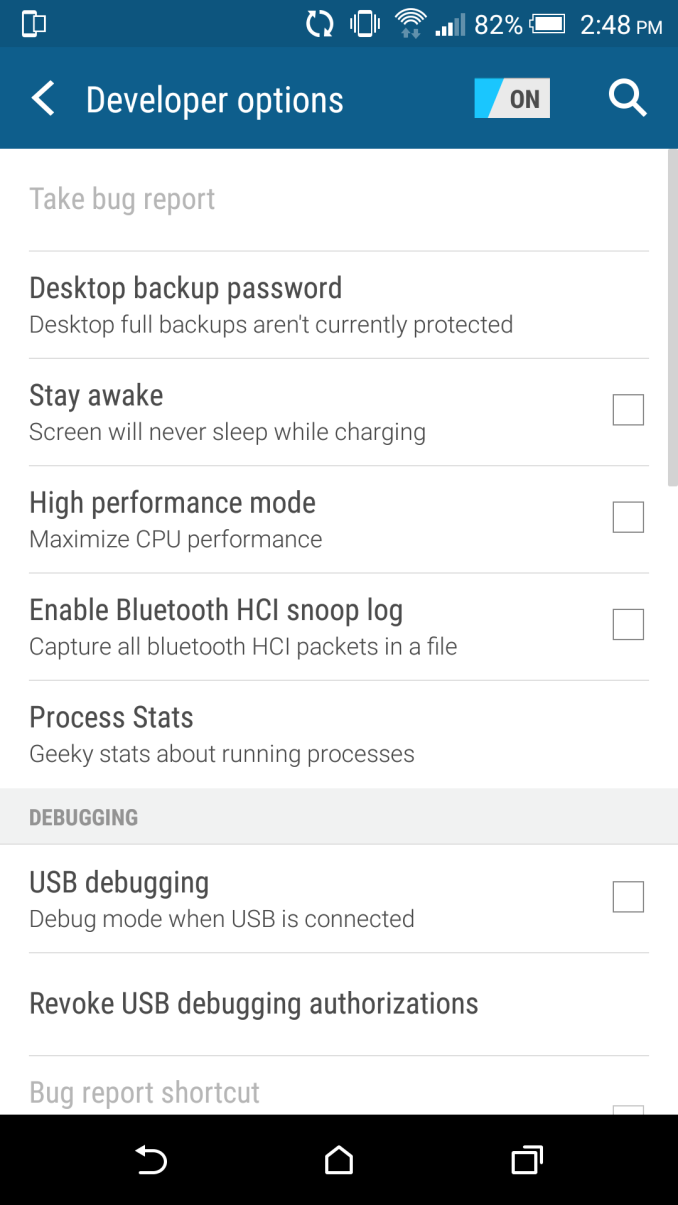








132 Comments
View All Comments
flyingpants1 - Monday, March 23, 2015 - link
Those are the dumbest reasons I have ever seen. One front speaker is infinitely better than one rear speaker. IR blaster is a gimmick feature. Amoled.. You're blaming Amoled for lollipop being white.. Jesus.hughlle - Tuesday, March 24, 2015 - link
One front speaker is worse than 2 front speakers. You call it a gimmick, others call it a great feature; I certainly wouldn't buy a new phone if it didn't have an IR blaster. And no, where did he blame amoled? He said that because lollipop is so white then the power saving ability of amoled is not really relevant in lollipop.Nice try and trying to spin everything though.
flyingpants1 - Monday, March 23, 2015 - link
Lol.. You can get used to having no buttons. You know like LG, Sony, Nexus 4,5,6, Motorola..You can't get used to having no front speakers.
Also the M9 has mSD which allows me to dump 128gb of music on there, or record 1080p videos continuously and switch out cards.
Black Obsidian - Tuesday, March 24, 2015 - link
Of course you can get used to having no front speakers. It's not as though rear-facing speakers don't work at all.Presumably the M9 also comes with a headphone jack and Bluetooth audio functionality, both of which offer listening options incomparably better than crappy phone speakers, whatever their orientation.
Notmyusualid - Wednesday, March 25, 2015 - link
I must humbly disagree with you Sir.Whatever 'other' audio connectivity exists, that will not suffice if I lean over to the phone in the car whilst in its holder, and choose to answer with 'speaker'. My GS5 can barely be heard, so bad to the point that I end the call and dial back when I stop.
I drive many company / rental cars, I'm not bluetoothing to each and every one, and I'm not the greatest fan of bluetooth headsets.
Notmyusualid - Wednesday, March 25, 2015 - link
No Sir. I can't get used to having no physical buttons, or M9 it would be for me.It matters not how many devices in existance have them, for I simply find them too buggy to use, they take up valuable screen space, and their nature of appearing / dissappearing gives me chest pains, for want of a better description.
And yes, once you've have had 'quality' front facing stereo speakers, 'it just seems illogical to do it any other way'.
lucam - Sunday, March 22, 2015 - link
Dear Anand,Why you haven't used the new GFXBench 3.1 as well as the new Basemark ES 3.1?
Andrei Frumusanu - Sunday, March 22, 2015 - link
GFXBench 3.1 was recently released only 2 weeks ago and is currently only available for Lolipop devices. We will adopt it in future reviews, but for now we can present more useful comparison data for 3.0.arayoflight - Monday, March 23, 2015 - link
Do you have a Galaxy S6 for review?Also, I think the Manhattan 3.0 and T-rex are more representative of real world performance then the ultra-high load of 3.1 in which the one with more compute performance wins.
lucam - Monday, March 23, 2015 - link
True, but the same was told last year for Manhattan 3.0 as it was very compute for that time.I guess in about 6 months- 1 years all mobile devices will run the new GFX 3.1 smoothly.